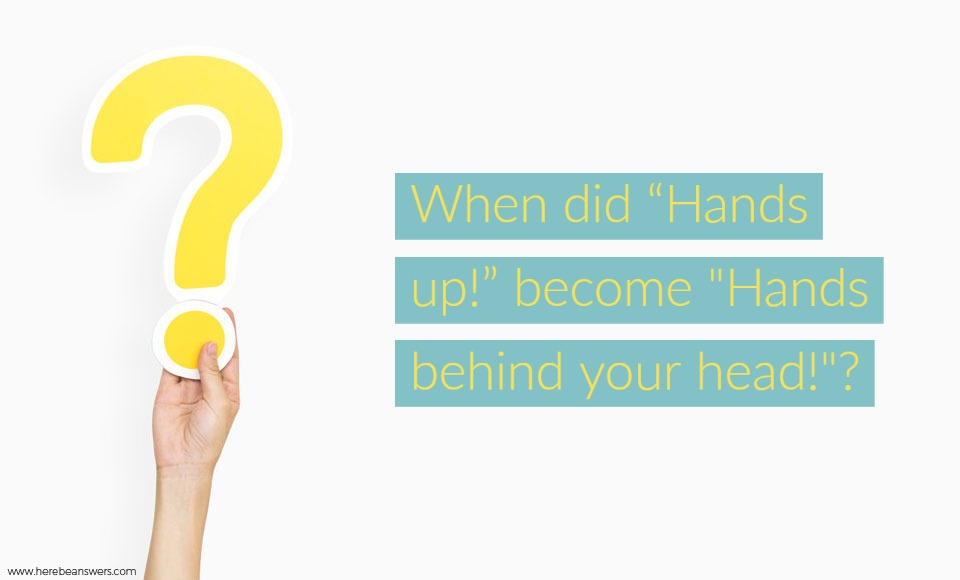Police sirens are ringing. Red and blue lights dance across the walls of buildings. There seems to be commotion outside. Timmy gets up from his bed, dashes to the window, and sees a crestfallen culprit caught by a team of armed police. The officer in the middle holds his stance and says, with authority in his voice, “Put your hands behind your head and turn around where I can see them!” The wrongdoer obeys, and the officer at the leftmost disarms and cuffs him. Soon, the police and the offender are long gone, off to face justice.
Then it comes to Timmy’s head: In the TV shows where his favorite Superhero helps the police catch the criminal, they say, “Put your hands up” instead of what the police said earlier. When Timmy and his friends play pretend together, they say, “Put your hands up,” too, out of habit. Since when has “Hands Up” become “Hands Behind your Head?”
The police, the security forces, and similar officers are responsible for the maintenance of public peace and order and the prevention and detection of criminal activity. In short, their job is to keep the people around them safe. However, as they do this, they need to keep in mind their protection and welfare as they defend for others. If they don’t take proper caution, their purpose would be defeated. Years of training and actual work have contributed to studying and devising ways to protect those who protect us.
But, criminals train and come prepared too. They devise their plans, and while they do so, prepare themselves mentally and physically. Whether they come from gangs or enterprises or simply work solo, it would be unwise for them not to practice how to escape from the police or take offense to get away with their task. Learning how to avoid being cuffed, overcome officers, and do extensive bodily harm are just some of the things they have to master.
However, some techniques become too familiar and predictable that the security already has a prepared set of responses. This causes them also to arrange new means to run away. This is why police tactics change over time. From “Hands up,” “Hands behind your head” is used. For the most straightforward reason, it would be easier and faster for a criminal to take a sudden action and grab a gun if “Hands Up” was used. Some officers even ask for them to interlace their fingers to make it seem even more troublesome for them to make a move.
If the individual was merely asked to put his hands up, he or she could easily assume another position that puts the Security at more risk. The hassle of choosing to make another move when one’s hands are interlaced causes lesser movement and less chance of harming, making this a safer option for the police rather than a simple “hands up.”
It is during cuffing that police officers are in a more vulnerable position because they are closer to the wrongdoer. Hence, the practice of defensive tactic police offers use called “Speed Cuffing.” The officer’s attention is divided between handcuffing and controlling the offender, and so quicker cuffing lets a police officer be safer. Speed Cuffing, as implied by the name itself, gets the officer in and out of the cuffing process much swifter. Getting the suspect to put his or her hands behind the head puts him or her at a challenging position, which allows Speed Cuffing to be done if appropriately conducted. (click here for more details)
It also is easier for the officers to watch the suspicious person’s head and hands this way rather than having their head and hands farther away from each other. Some resisting offenders choose to move their heads first or incorporate it to an overall reaction, so with this in mind, keeping an eye on both hands and head at proximity makes things more convenient.
When officers want to search suspects, it’s safer and more appropriate for them to put the hands behind their heads so their hands are away from pockets and waistbands or other places where weapons can be hidden. It would be more difficult for them to straighten out their arms to cause any offense while the search is happening.
As stated earlier, police officers are working out ways to help them do their jobs more efficiently and effectively. When suspects comply and put their hands behind their heads, officers are at a step closer to a safer position. However, who knows? While they may succeed today, groups and individuals who ought to cause trouble are also working to have the upper hand. From “Hands Up” to “Hands behind the Head,” these phrases are cautions that may change for the safety of the officers and the community.

